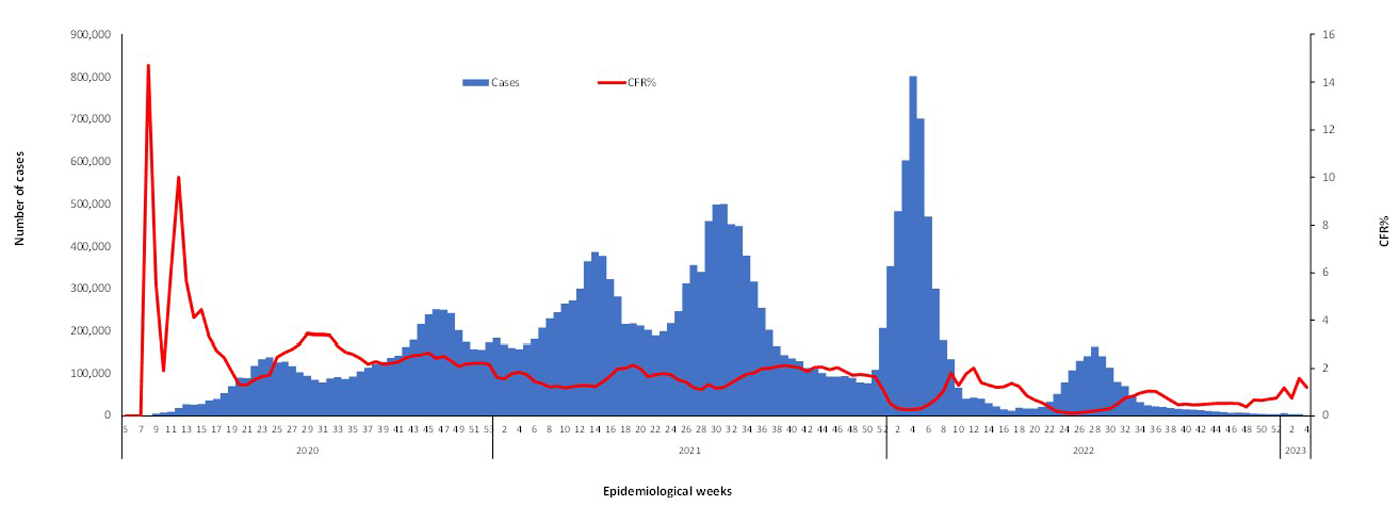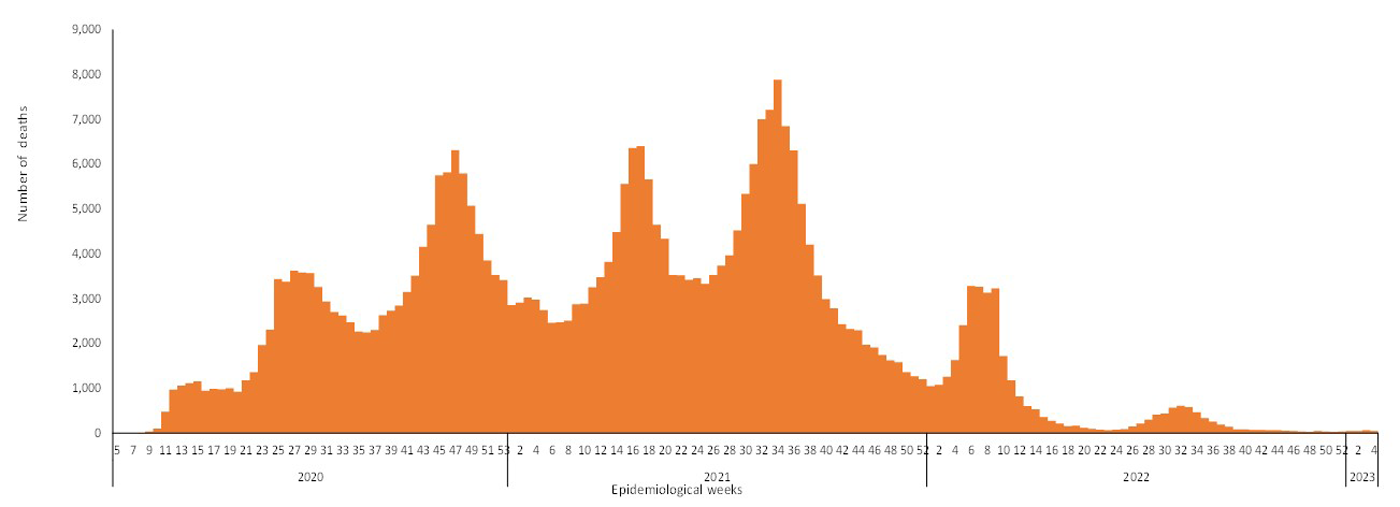The coronavirus disease COVID-19 continues to spread at the regional and global levels. As of 28 January 2023, the global cumulative incidence reached 753 223 014 reported cases and 6 798 268 associated deaths at a case-fatality ratio (CFR) of 0.90%. Meanwhile, the 22 countries of the Eastern Mediterranean Region (EMR) have reported a total of 23 242 505 cases, representing about 3.1% of the global count, with 349 307 associated deaths (CFR 1.5%). Most countries in the Region are in the community transmission phase.
Since the beginning of the outbreak, the country that has reported the highest number of total cases in the Region is Islamic Republic of Iran (7 564 046; 32.54% of the Region’s total), followed by Iraq (2 465 545; 10.61%) and Jordan (1 746 997; 7.52%). Islamic Republic of Iran also reported the highest number of total COVID-19 associated deaths (144 744; CFR 1.91%), followed by Pakistan (30 640; CFR 1.94%) and Tunisia (29 308; CFR 2.55%). The highest CFRs were reported by Yemen (18.07%), followed by Sudan (7.84%) and Syria (5.51%), while the lowest CFRs were reported by United Arab Emirates (0.22%), Bahrain (0.22) and Qatar (0.14%).
During epidemiological week 4, the Region reported a decrease in cases by 7% as compared to the previous week (3994 cases compared to 4289 cases). A decrease by 29% was also observed for associated deaths (48 deaths in the current week compared to 68 deaths in the previous week).
The weekly number of cases have decreased in all countries of the Region except in 4 out of 22 countries as compared to the previous week. This week the number of COVID-19 associated deaths also decreased in all countries of the Region except in 3 out of 22 countries as compared to the previous week.*
In terms of testing, a total of 443 731 120 laboratory tests were conducted since the start of the outbreak across the Region, including 329 273 tests in week 4, which shows a 13% increase as compared to the previous week when 290 841 tests were conducted. The highest number of PCR tests were reported from United Arab Emirates (198 580 705), followed by Islamic Republic of Iran (54 999 885) and Saudi Arabia (45 037 090). The average positivity rate for the Region is 5.24%. WHO recommends a positivity rate of around 3% to 12% as a general benchmark indicating adequate testing, which was achieved in most countries of the Region.
Meanwhile, COVID-19 vaccination continues across the Region. The total number of doses administered so far in the 22 countries is 862 073 749. Pakistan has administered the highest number of doses at 333 085 477, followed by Islamic Republic of Iran at 154 942 435 and Egypt at 101 357 078. On the other hand, Bahrain (3 476 633), Yemen (1 242 982) and Djibouti (338,051) administrated the lowest number of COVID-19 doses in the Region.**
Supporting countries in the Region
The regional incident management support team continues to coordinate the response and provide technical support to countries and partners in the Region in the areas of coordination and partnership, surveillance, laboratory capacity, clinical management, infection prevention and control, risk communication and community engagement, points of entry according to the International Health Regulations (2005), research, health systems, and essential health services among others.


For more data from the Region, please visit the COVID-19 dashboard.
*Reporting on weekly relative difference instead of cumulative difference to better reflect the extent of the COVID-19 pandemic as we witness a decline in reported cases. This decline could be partially due to the change in the frequency and quality of data being shared by some countries as they moved to reporting through weekly aggregated data.
**The data on vaccination is obtained from a number of sources including media reports and country websites for ministries of health.
Subscribe to the monthly infectious hazard preparedness newsletter of WHO’s Health Emergencies Programme for the latest data and analysis on the epidemic- and pandemic-prone diseases, as well as news on outbreak preparedness and response within WHO’s Eastern Mediterranean Region.


